#homophobic? more accurate considering the circumstances
Explore tagged Tumblr posts
Text
tras trying to claim something is a human rights violation against trans people when it also affects every other citizen is so funny like...yeah we know you're human too but how is that specifically about trans people come on now 😭
#'we lack the right to abortions' no only females can experience that not just trans people#'we lack the right to marry' not even true#'we lack the right of bodily automony' children being denied medical transition bc its not proven to help them and lacks scientific backing#is not a human rights violation#'we lack the right to compete in sports' no you don't its just sex based#'we lack the right to education' again no you don't lmao and schools refusing to teach queer theory to children also isn't a human rights#violation#homophobic? more accurate considering the circumstances#again again again nothing is a human rights violation trans people have rights yall just wanna complain 😭#the closest one that possibly could be considered is the ban on expression/clothing in some states that are in govt seshs rn#closest one that i could see harming many people and being a clear constitutional violation especially#that's it tho...and considering so many US trans people wanna claim theres a genocide going on...yeah sure
181 notes
·
View notes
Note
6 and 18 for any (or all) OCs
6. How does your oc feel about labels? Theirs, or in general?
There's a cultural context to consider for a few of the OCs. For Maru and Hazel, who presumably exist in a world similar to our own, their upbringing and life experiences do dictate a lot about how they feel about labels. Hazel was around queer people from a very young age and the term lesbian has been a title she has comfortably worn for most of her life and all her unlife. Hazel's childhood was in NYC and her adolescence was in Atlanta Georgia. Being a lesbian and proudly saying so is armor, despite it all.
Maru grew up in Kaidan where queer life is very different and their identity wasn't ever talked about or addressed. As an adult they tried on several different titles and labels and really just- none of them stuck. They have a more casual attitude, where their gender shouldn't be a factor in their life, but don't really make waves about how others gender them- despite how they feel.
Red lives in the world of Creation. She grew up in the Realm, an empire of dragonbloods and is a member, albeit disgraced, of House Cathak. Across the great houses, marriage and having children is one of the most important things in a dragonbloods life. Now this could go very homophobic, and say queer relationships are forbidden, I have decided that's stupid. This is a world full of spirits and magic and superpowers. Of course theres magic and spirits and powers that can make it possible to have kids if there are any obstacles- whatever they may be. Identity ain't really a problem or a worry so long as you DO your social duty of making the next generation of dragonbloods. Hell, even polyamory and having open relationships is widely accepted- so long as you're making more dragonbloods. BUT that doesn't mean citizens, particularly Red, would WANT to perform this social obligation. As a result, her relationship to her sexual orientation is touchy. To admit being attracted to someone would mean she could end up in the same cage that encased her mother, her grandmother, and countless warriors before them. So she really doesn't utilize labels like lesbian or queer- there really aren't words for those things in High Realm anyways. She's just the disgraced daughter of House Cathak- in so many ways. Anathema, unmarried, childless.
18. Do you prefer to give your ocs specific labels, or keep it unspecified? Why? If applicable, do you change their labels depending on circumstance?
I prefer to use they them pronouns for Maru and refer to them as genderqueer, but honestly, it's whatever. I just switch it up bc Maru is somehow all of them and none.
For Red, I will jokingly say her orientation is Atalanta energy or "attracted to anyone who can beat her in a fight," but it is VERY accurate. Shout out to Tepet Ejava for punching her lights out.
2 notes
·
View notes
Text
Berkowitz and the Inverted Electra
Hello! Well, this is where i’ve been all this time. This post required a lot of sourcing and research, and therefore a lot of time, because it’s very theoretical. Anyway, here’s my magnum opus. Enjoy.
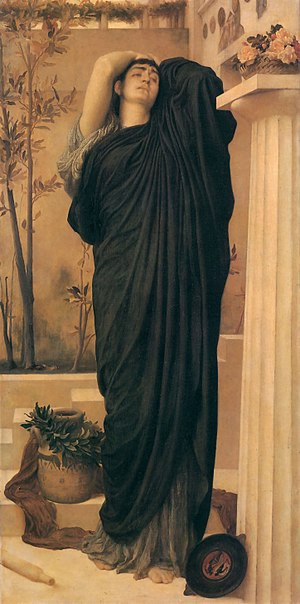
An Electra Complex is defined by the psychosexual relationship between a girl (or, in the ‘inverted’ sense, a boy) and her (his) mother, coupled with a sexual desire to possess their father. Oedipal and Electral urges originate during the Phallic (3rd) stage of psychosexual development.
As a male, Berkowitz would be expected to cleave to the Oedipal urges to kill his father/possess his mother; however, I don’t think this is the case. The Phallic stage takes place between the ages of 3-6 years old, around the time that Berkowitz was informed of his biological mother’s death, and his biological father’s abandonment of him. This, coupled with the continuous image of death surrounding women as he was growing up [1], helped to solidify this inverted Electral urge, the fascination with death&women and possession&men. In terms of possession and men, Berkowitz would have thought that only his biological father was still alive, and this developed (particularly later in his life) a great need to find his father, to reclaim some part of himself, and rid himself of the guilt he felt for driving his father away after (as he thought) killing his mother [2]. Another scenario during which he exhibited possession&men linked directly to death/control&women was when he would be taken to indoor pools and witnessed the thrall and power which men held over women, particulalry in situations in which there is sexual subtext, such as changing rooms [3].
So, great. He’s attracted to the same sex (more on this later) and death&women are interdependent concepts for him. What next? For Freud, it’s the Latency stage. This stage begins at age 7 and continues until puberty, which for boys is around 12/13 years old. This is the stage at which the Oedipal/Electral complexes begin to dissolve in order to decrease the tension and take on their gender role (whatever that may be) as the child realises that sexual gratification exists without, not within, their parents. At this stage is usually when the child begins to become more comfortable with the same sex parent--but David has always been more attracted to the idea of his biological father, as it is all he has. It could be said, then, that the Electra complex was forced upon him by circumstance, the circumstance of his adoptive-father’s lie about his biological parents. Regardless, Berkowitz eventually becomes very close to his adoptive mother, Pearl, and began to vie for her attention, such as poisoning her parakeets in order to have nothing to compete with for her affection [4]. The typical progression of Berkowitz is entirely inverted in terms of Freudian psychosexual stages. This is a stage of negated sexuality, hence the attatchment, traditionally, to the parent of the same sex, and to make friends of the same sex; however, because Freud’s an asshole, he doesn’t consider that ✨homosexuality✨ is a concept and thinks that all children must go to the parent/friends of the same sex as sexuality cannot be prompted here. But we can take liberties here because we live in the real world. There’s nothing abnormal about Berkowitz, he was just following the pyschosexual stages as somebody interested in the same sex.
Woah! You say. But he killed women because of pent-up sexual frustration! The gun is his penis!
Sure. For most; but I’ve always felt that Berkowitz did things a little bit... differently.
The Genital stage, or the final stage, begins at puberty (12/13) and continues/ends into adulthood. As traumatising as Pearl’s death was for David, her death coincided perfectly for her metaphorical death in the psyche of 13-year-old David. During the Genital stage, sexuality is no longer ‘hidden’ (latent), and rather becomes a thing necessary to be fulfilled for emotional release. Attention turns once more to the gender in which one is interested, and David, growing up in the culture that he did, turned to women. At 15, he had his first sexual experience, a blowjob, and sources (unknown) state that he preferred ‘oral sex and petting over regular intercourse’[5]. It would be plausible that he perhaps came to prefer this, considering his one known experience with ‘regular intercourse’ resulted in a venereal disease, but I’ve always contended that maybe he preferred so-called ‘petting’ due to his... less favourable position with heterosexuality. But, as I said, I feel as if David did not explore, or rather felt he could not explore, his sexuality until later on in his life (and, even then, due to his Baptist beliefs, promoted homophobic views because, y’know, Christianity and being born in the 50s) and was, in fact, more interested in men than women. If this is grabbing at straws for anyone, I will mention his ‘homosexual fling’ [6] with inmate Gary Evans, who was long suspected to be bisexual/homosexual due to his collecting of gay magazines and, according to Hugo Harmatz, ‘love letters’[citation needed] from Berkowitz stashed amongst them.
An addendum about Berkowitz’s latent stage: when he was around 10 years old, his parents had sex whilst he was in the same bed [8]. What could be more confusing, traumatising, and shaping, than your parents doing... that... during one of the most sexually devoid periods of your life! I believe this shaped his view of performance hugely. He was shown, at a formative period, that it was okay to perform in a sexually motivated manner whilst other people were around--non-consenting other people, at that. I believe that this is the reason he took his killing out into the open. It was a sexual thrill, the killings. It was heavily related to the sexual negation of wanting to kill your mother in order to possess your father. I am by no means saying that this is Berkowitz’s 100% proven, uncontestable motive, but the ideas of psychosexual analysis seem to apply to him in an accurate and very curious way. The traditional, heterosexual view of these stages do not match up to his psychology, but the homosexual interpretation does.
So, we move forward to his early 20s. He returns from Korea, looking for his father, the only piece of his biological existence he believes to be alive. He still wishes, all these years later, to possess the father--the destruction of the woman has only intensified after multiple failed attempts at dating, a horrendous virginity-loss experience, and the frustration surrounding an attempt at heterosexuality. But, here we stand: his biological mother is alive, and his biological father is the one who is dead. How terribly, terribly confusing. And still, Berkowitz attempts a relationship with his biological mother and half-sister. This goes south, however, when he discovers that he was given up due to being born out of wedlock, and he drops contact with his biological family.
The disollusionment is unfathomable. His biological father, his raison d’etre, is dead. His adoptive father has moved to Florida with his new wife: this new wife has fulfiled Berkowitz’s Electra Complex, in his mind, at least. Kill the mother. Take the father. His biological mother is not who he wanted to have. His adoptive mother is dead. What is left? A display of fulfilment, sexual fulfilment, as public as it has always been shown to him--through the bedroom of his parents, through the public changing rooms. Murder on the streets. Getting to kill a woman as he always thought he had been decreed to from birth, from his first supposed mother, his biological mother.
(bibliography under the cut. thank you for reading)
Bibliography:
Radford University: Berkowitz, David [3, 8]
Simply Psychology: 5 Stages of Psychosexual Development
Tumblr/Berkowitzbrat: Exploring the Why [1]
Tumblr/True Crime and Cannibalism: David Berkowitz’s Timeline [5]
Westchester Magazine: David Berkowitz’s History in Westchester County [4]
Wikipedia: Phallic stage, Latency stage, Genital stage
Wordpress/Can’t Stop the Bleeding: How to Stuff a Wild Bikini [6]
Youtube: David Berkowitz: In His Own Words (1/9) [2]
And here’s my whole folder of resources for general Berkowitz reading materials and media: https://drive.google.com/drive/folders/1VKlZJwRR4bpoPzO7AejAMtAJaVoBGuTg
#psychology#david berkowitz#son of sam#holy shit i'm back!!!#freudian elements#freud#analysis#electra#oedipus#adoptive parents#biological parents#discourse welcome
80 notes
·
View notes
Text
The True Story Behind The Blair Witch Project (1999), And The 13 Real Urban Legends About Witches That Will Make You Lie Down And Cry
It’s been mocked, and it’s been made a cultural icon.
It kick-started a horror trend, and it kicked itself down to the dregs of the film industry.
The Blair Witch Project (1999) is a point of contention among horror fans - you know, a bit like bringing up trans-rights at dinner with your UKIP Aunt sitting two seats down. But, just like trans-rights, we have to talk about it.
(Fuck you, Jane.)

The Blair Witch Project - and her 2 sequels - was the first film to turn on the camcorder and document the search for something supernatural.
This was the OG clickbait, this was the beginning of horror films claiming to document true events (ahem Paranormal Activity ahem), and this was the end of horror films being taken seriously.
But it was also these three things that grabbed everyone’s attention.
The original film was based on the claim that in 1994, 3 students went missing whilst exploring the supposedly haunted woods of Burkittsville Maryland. 5 years later, the footage they captured was found and put on the big screen.
Were these real events being documented?
Did these kids actually go missing?
And was the Blair Witch real?
Spoiler alert: no, nope, and not at all.
But even if this specific case wasn’t true, the film itself is unnervingly accurate. Like, literally last night I was researching all the different urban legends relating to witches in the US and I was convinced I had awoken the spirit of the Bell Witch.

So, considering the solidarity I have with the followers of this blog, I’ve decided to traumatise you, too.
This article is going to provide the summary to the three forgotten ‘n’ fucked-up films that make up the series, tell you why the Blair Witch is an uncomfortably accurate portrayal of witches historically, and finish up with a stroll through the 13 urban legends that are just like the one featured in the film.
Pull on your hiking boots, and hand me the map.
Let’s get spooky.
Here’s A Quick Summary Of The Blair Witch Film Series
Ahh, the 90s.
Will Smith was gettin’ jiggy with it, and Trump wasn’t President. Times were so much easier back then!
Well, not for budding film students Heather, Mike and Josh, who packed up their filming equipment in a car and headed to Burkittsville, Maryland to make a documentary about the urban legend of the Blair Witch. (The Blair Witch Project (1999))
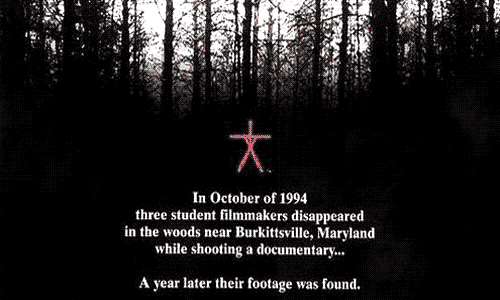
They start off by interviewing locals, and capture a few key details that set up the rest of the film and its sequels. It is claimed that Rustin Parr was a bloke who lived in the woods and kidnapped several children in the 1940s.
Why? Because the Blair Witch told him to do so. Two fishermen confirm the legends of the woods being haunted, and mention some lass called Robin Weaver.
Kidnapped in 1888, she returned 3 days later, claiming the witch was “an old woman whose feet never touched the ground."
Having heard the tales and waited out the warnings, they begin their journey and head to their first stop, Coffin Rock. Supposedly, 5 men were murdered in a ritualistic fashion here in the 19th century, and their bodies disappeared without a trace.
The next day, they continue their travels, and their ordeal begins. They arrive at an old cemetery which is made up of cairns (piles of rocks which turn out to have ritualistic meaning) and camp nearby. Noises are heard round the tent all night, like twigs snapping, but they reduce this to woodland creatures.
The following day, they realise they are lost and cannot find the car. The activity escalates, but is found to be unexplainable.
They then begin to fight between each other, and encounter a section of humanoid stick figures hanging from the trees. Their evening entertainment of weird noises around the tent resumes, but this time the laughter of children is added to the remix. Something then attacks their tent, sending them fleeing from their campsite.
Some people will just never like dubstep.
They return to their tent, and discover that their possessions have been rifled through, and slime covers Josh’s stuff. The fighting ensues, and Josh straight-up fucks-off.
His screams are then heard one night, and Heather and Mike deduce it to be the witch’s fabrication to draw them out of their tent and into her grasp.
Her trap is confirmed when Heather finds a bundle of sticks the next morning containing a ritualistic goody-bag containing what appears to be left of Josh.
That same night, she records her infamous apology video in a style not dissimilar to most YouTubers who have been caught being racist/homophobic/[insert any terrible thing].
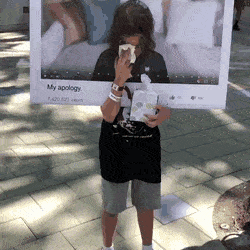
Once again, Josh’s screams are heard and they follow them to a house bearing demonic symbols and the bloody handprints of children. Not the aesthetic I myself would go for, but it worked for the Blair Witch...
Mike and Heather stumble into the basement, and we witness our favourite vloggers being killed in the manner described earlier in the film:
One child would face the corner of the basement while the other was being slaughtered. The last shot of the film is of Mike standing in the corner of the basement, suggesting that Heather is the first to die at the hands of the witch.
The second film (Book Of Shadows: Blair Witch 2 (2000)) follows up on these events a year after the footage was found. A gaggle of fans of the original film troop to Burkittsville to explore the legend and the circumstances of the kidnapping of Heather, Mike and Josh.
This film is messy and complicated, and it’s for that reason that I don’t want to waste 8,000 words on a film that is actually ignored by the film series. So, I’m going to give you a tl;dr, instead:
Basics, this film documents the group of fans and tourists being turned against each other by the witch. They go to the house where shit reportedly went down, and set up surveillance cameras to document potential activity.
It’s the first film, but with hell of a lot more activity. And it culminates with the symbolic hanging of someone who appears to be inciting the demonic rituals scattered across the film as they are reportedly possessed by the Blair Witch.
Unfortunately, we don’t learn anything new in this film - we simply see the greater extent of her powers.
Tired, yet?
(Bored, perhaps?)
Our journey is almost over, and it ends with Blair Witch (2016).
This film ignores the events of the second film, and follows a group of documentary makers as they explore the legend of the Blair Witch - but this time it's not about capturing paranormal activity. They go to investigate a peculiar video on YouTube that proves that Heather - the woman from the OG cult classic - might just be alive.
The brother of Heather leads this group, and focuses this documentary on the desire for closure.
Despite skipping out the Book of Shadows, it basically sticks to that exact premise. Surveillance cameras are set up, and showcases the witch’s methods of turning the crew on each other, but on an even greater level. We even see the witch, alongside a couple other creatures in tow...
It finally gives us behind the scenes insight into the paranormal activity, and ends with everyone dying!
Sigh.

The Blair Witch Is Based Off Of Urban Legends - And Is Uncomfortably Similar To The Stories
Despite its many flaws, The Blair Witch Project does one thing right: we never see the witch.
But it’s the way that her control of the woods and those within it is portrayed that points to the terrifyingly accurate nature of the witch when compared to other urban legends.
The film’s fictional legend gives up minimal information regarding the Blair Witch:
We know she was responsible for residents - especially children - going missing throughout the 18th and 20th century, and we know that the locals of Burkittsville claimed that the Blair Witch was the ghost of Elly Kedward, a woman who reportedly practiced witchcraft and was sentenced to death in 1785.
This salem-witch-what-died-but-didnt-really-die-no-one-really-knows is a common basis of the urban legends that will be explored later in this post, but it's the other attributes of the witch that draw her even closer to the claims made around these cases.
The focus of this is that the Blair Witch represents the crone, one of the core concepts of paganism and many other ancient religions. Of the few glimpses we see of a creature that could be the witch and the descriptions of her made by the locals of Burkittsville, we piece together the image of an elderly, monstrous being.
Take this clip from the final film in the saga:
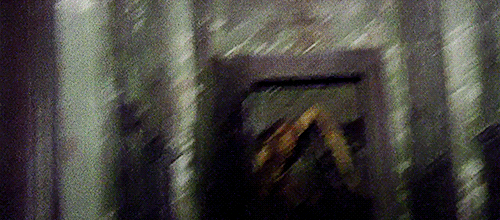
This unnatural-looking humanoid bears a resemblance to the claims of witches in folklore, such as breasts sagging below waistlines, or bones jutting out of their flesh. Add on top of this the animalistic claims from the original movie - like that one woman claiming she saw her arm which was coated with dark hair - and we arrive at a rather monstrous being.
But this animalistic account does not merely echo her ugliness; it forges the link between the witch and her powers over the woods she resides in.
As the maiden becomes the mother, and the mother becomes the crone, her connection with nature grows. It reaches the extent from which her connection with nature is greater than that of her male counterparts, threatening almighty patriarchy and cursing her as the evil witch she is!!1!
Furthermore, it's not difficult to see the links between the woods she controls, and the imagery of life and fertility. Add a smattering of rumours about kidnapped children, and the house of Rustin Parr becomes a womb.
(Less PMS, more blood.)
More so, by harnessing the powers of nature, she blurs the boundaries between the genders. Heck, she even goes as far as to blur the boundaries between reality and the reality she creates for her victims!
She tricks them into falling out with each other, she confuses them by creating this unnavigable wood, and she ensnares them into her invisible trap.
Or, translated into simple terms, the Blair Witch fulfills the concept of the Monstrous-Feminine, a theory conjured up by Barbara Creed. On one hand it suggests women are either portrayed as the victim within horror films, and on the other it suggests that when the woman becomes monstrous, she takes on extreme attributes regarding the female reproductive body.
Guess which one the Blair Witch is.
But this theory didn’t start with Babs sitting in a room and getting her feminist on - Creed deconstructs notions that can be traced back to the era of the Salem witch trials. Each and every urban legend starts here, when it was #on-trend to burn your local witch.
The Blair Witch is the puppet master in these films.
And she is not the only one that is pulling the strings.
The Real Urban Legends About Witches That You Need To Know About
“So, the Blair Witch is some chick who hasn’t shaved in 3 months and has a metaphorical vagina?”
Ok, fair enough.
The Blair Witch isn’t directly based on a specific urban legend, so yes, delete the sage from your Amazon basket and buy those limited edition poptarts, instead.
…
Oh, you thought this post was over?
My little ghoul - this is The Paranormal Periodical. You didn’t think I’d let you leave without informing you of that witch roaming around your local area, would you?

‘Course not. Here are the 13 real urban legends of witches that’ll scare the shizz outta you.
#1 - Naale Baa
We trade in deep woodland in Maryland for Karntaka, India for this local legend. And within minutes of arriving, you’ll spot the word ‘naale baa’ on the walls - a decoration not dissimilar to that seen in Rustin Parr’s crib.
It is claimed that by writing these words on their walls they can deter the witch that wanders from house to house in search of her husband.
Glammed up in full bridal wear, Nale Ba (as she is also known) supposedly attempts to entice the man of the house, and then curse the family with bad luck.
In the 1990s, this urban legend faced a particular resurgence, and even evolved to claim that she would imitate the voices of victim’s family members to encourage them to open the door. But when the door is opened, you die!
How? No idea.
Am I still scared? Hell yeah.
But I’m not the only one concerned about this witch - claims that multiple men in Thailand just disappeared from their beds in the middle of the night were pinned onto this urban legend.
#2 - The Bell Witch
This is probably the most famous legend regarding a witch puppeteering an innocent family’s life.
The story starts in 1817. A family begin to witness signs of paranormal activity on their farm that targets the man of the house and his daughter, Betsy. A variety of large animals are seen across their farm and follow the family and their slaves. Strange noises then begin to fill the house, like invisible chains being dragged on the floor, or dogs fighting. Betsy repeatedly claims that she can see a little girl playing on the swings.
But this friendly ghost then begins to attack the child, slapping her and scarring her with pins.
The man of the house then begins to demand answers about these spooky shenanigans, and straight up asks the spirit what the shit is going on.
The spirit gives ‘em a lowdown of her backstory - a bit like those clips from the X Factor where they use Katy Perry’s Firework over the top of this 16 year old girl’s turmoil regarding GCSE maths - and claims that she is "Old Kate Batts' witch".
‘Couple of convos later and they deduce that the farm rests on a Native American burial ground, and the spirit has been disturbed.
Yet despite the specificity of this legend, the haunting sticks to familial lines we see with Naale Baa and the Blair Witch:
The witch claims she will leave - but she will return in 7 years. She kept her promise, and haunted Betsy when she achieved her womanly purpose of shitting out a baby and having a family of her own.

#3 - The Perron Family Farmhouse
This case was the inspiration behind the original Conjuring movie, founding one of the most iconic horror film series to date - and it’s clear to see why.
I’ve already done a fully-fledged post on this classic tale, but here’s a tl;dr for people hoping not to delve too deep into the haunting…
The Perron family made the mistake of moving onto the land once owned and now haunted by Bathsheba Sherman, a witch from the 19th century.
With increasingly violent activity beginning to haunt the family - which culminated in the possession of the mother of the house - this has earned its place as one of the scariest tales of terror to feature on this blog.
#4 - Mary Evelyn Ford
She was burned at the stake for her witchcraft.
She was buried in a steel lined grave, and her casket was covered with concrete to keep her trapped in.
Oh, and she was 5 years old.
It is claimed that Mary will wander ‘round the cemetery or stand trapped within the protective fencing around her graveside, making faces at mourners and enticing them towards her final resting place. From there she will suck you into the depths where her body now lies, and use your vitality for strength!
#5 - The Three Legged Lady of Mississippi
The American road trip.
A classic coming-of-adventure filled with freedom, spotify playlists you accidentally stream via your data, and running over people that are already dead.

No? Just me?
The story goes that there’s one road in Mississippi which is haunted by The Three Legged Lady. If you honk your horn three times, she will knock on the roof of the car, and race your car to the end of the road, hitting it with her body throughout the short journey.
Why?
Her origins, like most urban legends, have been subject to a lot of dispute, but there are 2 claims which follow this tale:
One side to the story claims she was the innocent victim of a sacrifice by a satanic cult, whilst the other side claims she doesn’t actually have three legs.
She’s holding her daughter’s leg, which was severed off when she was run over by a car. It is said that she is still looking for the rest of her daughter.
#6 - The Skinwalkers of Arizona
Our road trip doesn’t stop there, however - this time we are heading for the Navajo region of Arizona.
Supposedly, when you’re sailing down the highway, something will tap on your window, and you’ll catch a glance of a skinwalker. These humanoid, mutated beings were shapeshifters that were the witch doctors representing the evil within Navajo society.
This urban legend even featured in a court case when a woman was found brutally murdered!
Heck, there is actually a specific region of Arizona - Skinwalker Ranch - from which you are sure to these mystical beings.
#7 - Goody Cole, The Witch of Hampton
This urban legend sticks to the minimalist aesthetic, but nevertheless has earned its reputation in Hampton.
The story goes that a woman accused of being a witch was found dead in her house, and thus, to ensure this bitch stays dead, they bury her with a stake and horseshoe. She says six feet under, but her powers prevail; she curses those that happen to go past her grave.
Her curses stick to those sailing on the river by her burial site, including that one time she reportedly brewed a storm for an innocent girl enjoying a summer’s day on a sailboat who just so happened to be mocking her past.
Not a good day for yachting with father, then?
#8 - The Curse of Jonathon Buck’s Tomb
Okay, this one’s fucking creepy.
And I love it.

Jonathon Buck was one of the main lads in charge of the Salem witch trials, and condemned many a woman to death by burning. Unfortunately, his attempts to rid one woman of her alleged powers failed, and she scarred his tombstone with a burn mark in the shape of a leg.
No, seriously.
Whenever the tomb is moved, the mark reappears.
#9 - Mary Nohl’s Witch House
This origins of this tale can be traced to much more recent events, but carries the essence of an urban legend that rumoured witches cannot escape from.
Mary Nohl was a sculptor famed for her wacky art and weird displays that decorated her house and gardens. The local residents petitioned for it to be demolished, but it was placed on the National Register, instead.
It is here that the rumours began to swell:
The legend claims that her husband and son drowned in a nearby lake, so, she created these sculptures to watch out for them and await their return to their home. But it was discovered that she never had any children, voiding the rumours conjured up by teenagers after late night visits to this spectacular house.
#10 - The Pendle Witches
I’ve already covered this gaggle of witches and the legends they’ve left on Pendle Hill, but here’s a quick recap for those that haven’t already checked out that post:
The Pendle witches were a group of peasants who practiced dark and mysterious magic. From neighbours getting ill, to strange effigies being found containing hair and teeth, there was more than enough evidence to send them to trial.
It was on this hill that they were sentenced to death, and it was on this hill that they were hung for their crimes. But their witchy behaviour didn’t stop with their deaths.
Peculiar happenings still haunt Pendle hill…
#11 - The Surrey Witch
Our next urban legend is also resident to the UK, and even takes its form in the same era.
In the 17th century, a white witch lived in a cave in Surrey, and was known for lending things to her neighbours. All you had to do was stand on the boulder outside her cave and ask!
But one day, some bloke tried his luck, and asked for her cauldron. She was chill with it, but said he must return it by a deadline. He missed the due date, and lost 5% off his final mark he fled to escape her potential wrath.
He fled to Frensham church, from which the cauldron has been utilised for centuries. I wonder if the witch is still out there looking for it?
#12 - Tituba, The Voodoo Queen
Okay, so this witch might not have an urban legend tied to her memory, but her past mirrors the Blair Witch’s own story so it’s freakalicious, regardless...
Tituba was actually the first woman accused of practicing witchcraft in 1692. She even confessed to her crimes, and threw two other witches under the bus!
(So much for solidarity, guys.)
But her story follows a unique twist, as she was believed to have come to the colony she later resided in to encourage local children to take up Voodoo. Her focus on children and thus her maternal portrayal is a simplified reflection of the Blair Witches own metaphorical genitalia.
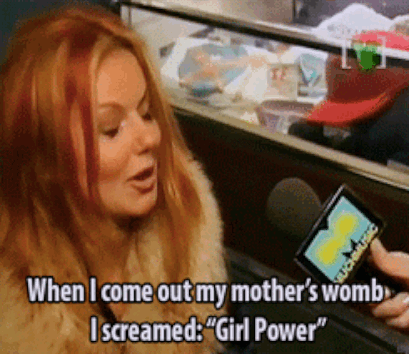
#13 - The Witch House, aka The Jonathon Corwin House
Our final urban legend belongs to one of the most historical buildings in Salem:
No, really, it’s the only structure in Salem still standing that had a hand in the witch trials. Not only has it witnessed dark and twisted histories of innocent people, it’s still home to some of them.
Jonathon Corwin - the former owner of the house - was a judge in the trials, and thus carried the memories of the trials with him back to his home, but with reports of torture in the basement and even his own burial down there after his murder, I think we can safely that many myths and legends will circle this house.
Add in a visit from the Ghost Adventures crew, and we can stamp on the Zak Bagan’s seal of approval.
No wonder it’s considered the most haunted house in Salem!
Now It’s Time To Hear What You Think:
Which urban legend is the winner of tonight’s fuck-off-i-cant-handle-the-spooks-man award?
And will you ever watch The Blair Witch Project again?
😍Up for more spooky stuff? Follow this blog and hear a new real ghost story everyday!😍
(Also this is me now.)

#the blair witch project#blair witch project#the blair witch project 2#book of shadows#curse of the blair witch#blair witch 2016#blair witch#blair witch project 3#the blair witch project true story#the witch project#heather donahue#elly kedward#rustin parr#based on a true story#based on real events#best horror movies#Horror Movies#horror films#feminism#feminist film#urban legends#True Ghost Stories#real ghost stories#paranormal evidence#paranormal activity#supernatrual#video evidence of paranormal#photographic evidence of ghosts#bell witch#The Perron Family
92 notes
·
View notes
Note
Fandom police is annoying. If you like a villain or a character who is complex, you're considered evil. If you like a ship, even if the ship pure but because of circumstances (one of the people in the ship has sacrificed themselves to save their lover) it's considered weird. Or if you like straight ships, you're considered "homophobic" even if you're LGBT or see the ship as bi or pan. I get certain disliking characters and ships, but why police others on what to like or dislike???
I don’t think I’ve ever seen someone called homophobic for shipping heterosexual pairings. But I can assure you that places like twitter and tumblr aren’t necessarily accurate representations of how the people surrounding you may feel. We are way more supportive of the LGBTQ+ community on tumblr, for instance, compared to the general public. Fandom police is tiring and irritating, but to a certain extent. We shouldn’t be making excuses for rapists or abusers. If you like a character that has abused or harmed other people, that’s your choice. But you shouldn’t try to excuse or rationalize these behaviors (like I said in my previous ask) because that’s harmful. If your fav is trash but you still love them, that’s really okay and I don’t think you should be attacked for it. But it’s important to acknowledge that what they did is wrong, or else these acts of violence/etc may become (even more) normalized. I know it’s just fiction, but we are exposed to a lot through fiction... even if it’s not real, a lot of these things happen in real life so it’s important to reiterate that it’s wrong and that you don’t condone these acts and behaviors in real life.
7 notes
·
View notes
Text
So on Friday night I made this post:
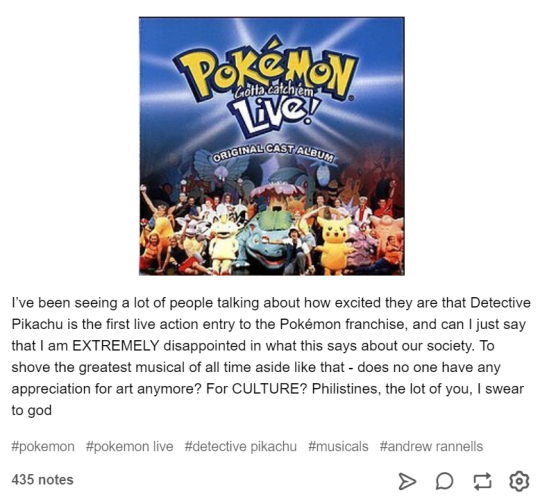
Which I expected that maybe ten, twenty people would see? I didn’t think anyone would really care about a joke about something so old and obscure, and it would just get lost in all the Detective Pikachu stuff. Instead, within five hours, it had become my most popular post.
I know it’s still not a huge number, but it’s still way more attention than I’ve ever received for anything... ever, so I’ve been thinking about Pokemon Live a lot since. Which has been bad, because this morning I had to take a very important political economy exam, and instead of thinking about Bretton Woods or Marx, I was thinking about Pokemon. I nearly referred to my country’s former Prime Minister as ‘David Camerupt’. It wasn’t good.
I need to expunge my thoughts. Specifically, my thoughts on one topic in particular - the way this show treats, or rather mistreats, the character of James. Because I truly, truly love Pokemon Live. I do. It’s one of the most glorious dumpster fires I’ve ever had the pleasure of watching a poor quality recording of. But this is the one thing I definitely don’t love.
I don’t expect anyone to read this. I mean, I said that last time, but this time I really don’t. It’s a long essay on a niche topic, and it isn’t even funny. But on the off chance it’ll get you to stick with me, I promise that there will be pictures of Andrew Rannells cuddling puppies at the end.
So,
How Pokemon Live Mistreats James, and Why It Matters:
The Mandatory Mentioning of The Actor
I’m guessing anyone who knows anything about Pokemon Live also knows that now highly successful, Tony-nominated Broadway and television actor Andrew Rannells was in it playing James. And if you didn’t, now you know why I’ve mentioned him twice now. I’m a big fan of this guy.
He hated this role. Absolutely despised it. Apparently the show was a miserable environment to work in for everyone. The costumes were uncomfortable. The audiences were unbearable. There’s a making of for this show, which can be viewed on YouTube in its entirety - I’ve watched the whole thing more than once and you can see in every cast member’s eyes - there’s no light there. They’re all dead inside. It’s almost heartbreaking.
To be clear - he’s the only one of these people I, or anyone else I’ve seen, ever makes fun of for this show. And that’s because he’s fine. He’s fine! He’s done very well for himself and talking about it won’t hurt his career, and there’s just always something really hilarious about seeing very successful people in terrible things, isn’t there? Chris Hemsworth in Saddle Club, Zach Braff in Babysitter’s Club, literally everyone in Foodfight. It’s not malicious or in any way intended to be punching down - just poking fun at a really good actor’s really bad early work. It’s not even really making fun of him, more that he was in this.
But there is one reason he hated the role that I don’t find so funny, and that’s that he felt the people that wrote the thing had made James a grossly over-the-top, borderline-to-over-the-line (depending on your tolerance) homophobic stereotype. And... yeah. They undeniably did that.
Rannells understandably dislikes the character, and to be honest - that makes me a little sad. Knowing that musical!James is probably the only version of the character he (and likely a lot of parents who saw the show, and other cast members) ever really encountered, that’s a huge shame. Because if we go back to the anime the musical’s based on, the one I, and many others, grew up on, James is quite different. In fact, I personally consider anime!James to be the best character in the entire Pokemon franchise.
Why We Love Team Rocket
Just want to quickly note that I can only discuss the anime up to about halfway through the Sinnoh seasons - I’ve seen basically nothing after that. My childhood was some original series, a lot of Hoenn, and a fair bit of early Sinnoh (somehow skipped over Johto almost entirely, don’t really know how that happened). If any of this is now not accurate, well - it’s not really relevant for this discussion anyway, but I still apologise.
The Team Rocket trio, James especially, is, pretty queer-coded. This is not unusual for villainous characters in children’s media before the 2010s, so much so that I would guess that a lot of the time it wasn’t even being done deliberately - it was just that common a trope that it was all but expected your show would have at least one flamboyantly effeminate, villainous bloke. And James - especially early James - has no qualms about showing his feminine side:
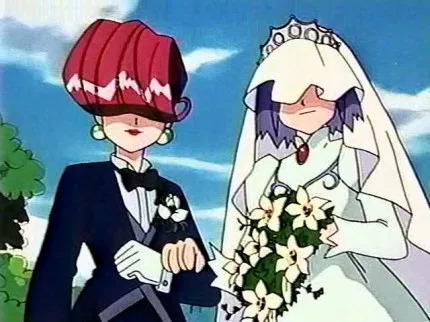
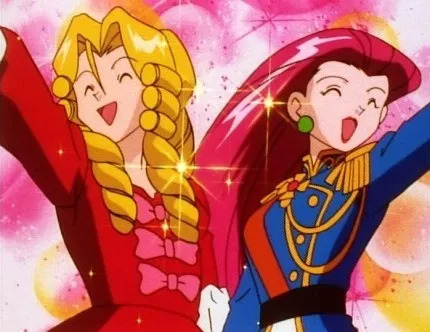
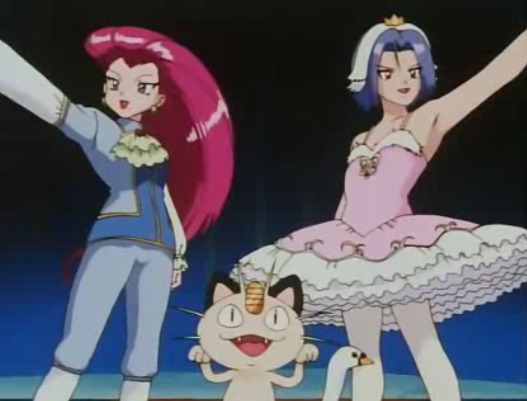
Notice that Jessie adopts masculine attire to match - she doesn’t always do this, but I like that they have her at least do it sometimes.
Team Rocket’s disguises became less and less likely to involve cross dressing as the show went on, but it’s one of the things best remembered about them. James also has a strong association with roses, and possesses several other feminine mannerisms. Arguably he’s far more downplayed than most other villains of the type (even more so than others present in Pokemon - Harley’s a great example, who was also, coincidentally, played by Andrew Rannells), but it’s present. And while yes, obviously in real life none of those things should be taken as definitive indication of a person’s orientation, and straight men are perfectly capable of twirling around in pretty dresses - in fact, I fully endorse it - this is fiction. Specifically fiction from the early 2000s. And in fiction, certain things are intended as visual cues and shorthand.
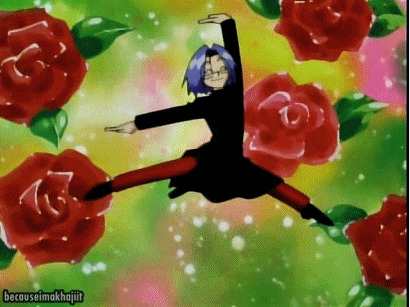
So I really, really doubt we were supposed to think James is entirely straight (I personally have always thought that he’s actually bi, but I’m not opposed to alternatives). You could make the case, but like. Come on.
But how is this different from musical!James? And how is this different than any other villain like him? Very simple. Anime!James has depth.
Not a tremendous amount. It’s a children’s cartoon made to cash in on a popular video game. But he, and Jessie and Meowth, are among the most well-rounded characters in the show’s cast, in a way that’s actually very relatable. It helps that they aren’t actually very villainous people most of the time. I know so many people who grew up with the show that loved, rooted for, and identified with them over the actual protagonists, by a mile. Myself included - I can remember two separate James-centered episodes that made me cry as a kid.
And these three are particularly beloved by young LGBT adults. We know from their backstories that they all came from rough circumstances - Jessie desperately poor and struggling to get anywhere or be recognised, Meowth having changed a fundamental part of himself in attempt to gain love and instead being ostracised for it, and James running away from an abusive household. They’re three people (/Pokemon) who felt alone in the world, that have now found each other. And whether you view Jessie and James’s relationship as romantic, friendship, or found family, it’s far more compelling than any other relationship in the show, at least to me. They may be criminals, but it’s not hard to see why some kids - especially the kids who might already feel like they’re just a bit different - would latch on to them.
Even if you didn’t know James’s backstory, he still has a character. He’s frequently shown to be the most moral of the trio, he has a stronger bond with Pokemon than honestly even Ash - even more of a running gag than his flamboyance is the fact that his pets love him so much that they just wanna hug him all the time, with inevitable slapstick consequences - he has dorky hobbies like bottle cap collecting, and he’s even occasionally shown to be a bit of an environmentalist. Yes he is in many ways a stereotypical camp villain - but he’s also more. And that’s why we love him.
And I’d bet anything there probably were some little boys who watched the show and saw James and thought ‘that guy’s like me!’. And yeah, that guy is a villain, because god forbid a maybe-gay character also be a good guy. But more than any other character like him that I’ve seen, he’s also always been a person. And considering how most of the other options kids like that had at the time were either one-note villains or nothing (and even now it’s sparse pickings) - that’s valuable.
And then there’s Pokemon Live.
*long, long sigh*
Oh, Pokemon Live. You beautiful disaster.
What did you do to my boy?
Is there nothing that better encapsulates it than the bit where James asks Giovanni where Mecha MewTwo (...I know) “stands on campaign finance reform, social security and Don’t Ask Don’t Tell”?
First off, I like that James is politically engaged! Good for him! Completely out of character, but still!
And I do find this line incredibly funny, but I want to be very clear about why I find it funny. The line is funny because referencing a real world American discriminatory military policy in a Pokemon musical is just... so completely absurd. It’s super jarring and when I first watched it, I had to pause it so I could stop laughing about the possible implications of Pokemon Don’t Ask Don’t Tell. Is there a Pokemon American military then? Pokemon Democrats and Pokemon Republicans? Pokemon Bill Clinton? POKEMONICA LEWINSKY???
It just raises so many questions.
Also Rannells’s delivery is incredible.
But the thing is, that’s not the joke here, is it? The actual ‘joke’ is ‘HA HA HE’S GAY! HE SAID THAT BECAUSE HE’S GAY!’. Which gets even worse when you think about it and realise that this situation is really just a gay man (I don’t think there’s any doubt about it in this particular incarnation, is there) asking his boss whether or not he thinks people like him should be discriminated against. How is that a joke? (The answer is that it isn’t.)
Which makes it that much more inappropriate for a children’s Pokemon musical, which is sort of, in a dark way, almost funnier. It’s that juxtaposition of something kiddy and cute with something that definitely isn’t.
But hilarious as I find it, given the chance to I would go back and get rid of that line. I dislike what it implies - that being a gay man is nothing more than a punchline - more than I like the absurdist humour.
And that’s the whole problem with how they chose to write James for this whole thing. They took a really good example of how you can have this type of villain while also making him a good character, and they turned him into nothing more than a stereotype.
You could say ‘but it’s a much shorter story than a TV show! They wouldn’t have time to make him nuanced!’, to which I would say 1. He doesn’t have to be nuanced, he just has to be slightly more than I’M GAY and 2. There have been 21 Pokemon movies at time of writing, two of which came out before Pokemon Live did. None of them, at least of the ones I’ve seen, committed any character assassinations like this. The first one even had another baffling reference to real world America:
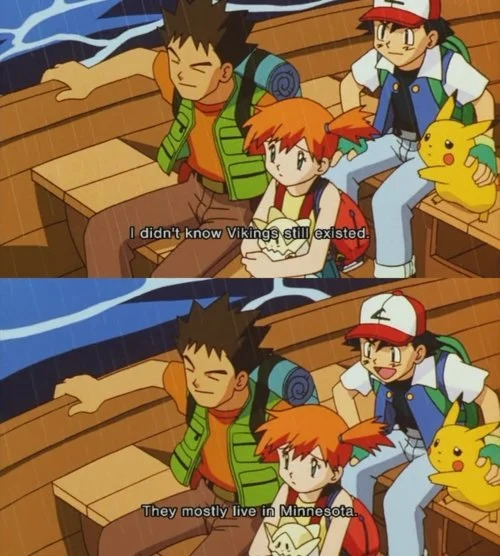
That’s so out of nowhere and silly that I laugh every time I think about it (the Minnesota Vikings are an American football team, if you didn’t know). See, Pokemon Live! It’s possible to do jokes like that which aren’t at the expense of a minority group! Wow!
The anime even has examples of how you can do the gay jokes and make them funny. They are very rare in the show (beyond the humour of James’s personality), but remember the whole Flaming Moltres joke? It’s actually great. It’s a couple of good puns, it’s possibly Rachael Lillis’s best delivery in the whole show, and, just for confirmation, I’ve shown the clip to a few actual gay men in my life, who all said that they think that it’s very funny, and totally non-offensive. The joke is still ‘lol he gay’, but it’s also a neat play on words, it feels very in character for both of them, and it doesn’t have the same malicious, taunt-y feel of the Pokemon Live ‘joke’.
Look, the Pokemon anime is far from perfect. There are lots of moments where you have to grit your teeth and remember when it came out. But it still gave us a really, really wonderful character, and he absolutely deserved better than this.
Do I Still Love Pokemon Live?
Yes.
Even with all of this, it’s still an absolute masterpiece of unintentional hilarity. In some ways, this makes it funnier. Of course, of course, it couldn’t just have terrible costumes and a nonsense plot and really, really bad rapping - of course it’s also kind of offensive. Of course it is. Why wouldn’t it be.
And I would love to talk about all the things I genuinely love about it, and maybe I will one day.
But the thing is, it’s also representative of everything that was wrong with gay-coded characters at the time, something that the show it’s based on came way closer to handling well than most other stuff of its time, no less. And that, as a whole, isn’t funny at all.
So I want to be clear. I love laughing at this show because it’s a weirdly earnest cash-in musical for something that definitely shouldn’t be a musical, with endless bizarre, quotable moments - not because the way it warped this character is actually funny. I love laughing at the character’s lines because they’re absurd choices for a Pokemon musical - not because they’re in any way funny on their own. And I love laughing at the fact that Andrew Rannells was in it because he is so much better than this - not because this is what I think he should be reduced to.
And speaking of, here’s those pictures I promised:
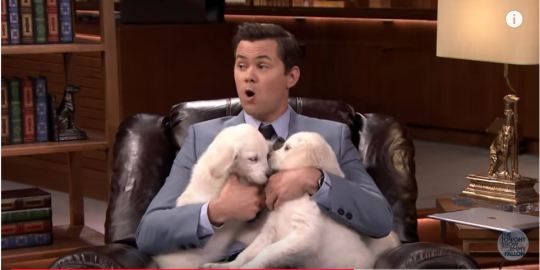
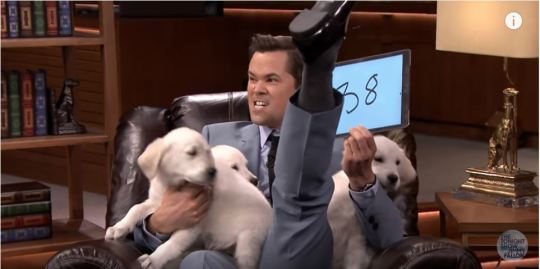


I love one man.
#pokemon#pokemon live#andrew rannells#james pokemon#team rocket#musicals#long post#i cant believe how long i spent on this#ive written academic essays shorter#i think this is probably longer than all my exam answers from this morning combined#long essays about niche topics
63 notes
·
View notes
Text
Trust Me: Chapter 7
Hey look! A timely update! Consider it a preemptive apology to everyone who loves Logan.
Chapter 1 Chapter 6 AO3 Chapter 8
Warnings: GRAPHIC DESCRIPTION OF TORTURE and JD is a high schooler. It’s relatively short, and marked by ******* before and after. But it’s for sure there. Oh, and some swearing.
Author’s Note: The German translates to “I speak German too, and I know you killed them.”
Word Count: 2190
Tag List: @ccecode @emo-sanders-sides-loving-unicorn @ren-allen @ilovemygaydad @bloodropsblog @funsizedgremlin @raygelkitty @roxiefox23 @thomasthesandersengine @spookyingarbageisland @band-be-boss-blog
15 minutes passed before Logan broke the silence. "I understand that two members of the football team committed suicide two weeks ago. I know that you are new to the school, but it must be difficult nonetheless."
"Not really. I bounce around so much, I don't bother learning names or faces, let alone care about anyone. Besides, I heard they did it because they were gay and too homophobic to deal with it. No major loss there, in my opinion."
"That is… an interesting perspective, JD. I am almost afraid to ask about your thoughts on Heather Chandler's death."
"Sometimes even the shiniest of ivory towers are prisons, I suppose. One has to wonder, though, how much the bullying rate has dropped since she kicked the bucket. I mean, sure, one of the other Heathers is trying to take her place, but even she knows that she'll never measure up." He looked out the window and then back to Logan. "Hang on, I never told you where I live."
"I know where I'm going. What do you know about how Heather, Kurt, and Ram died?"
"If you say so," JD began, hesitantly. "Only what everyone knows. Heather drank drain cleaner, and Kurt and Ram shot each other. I heard someone saying that they used some special kind of bullets called ich lüge."
"Ich spreche auch Deutsch und ich weiß dass Sie sie umgebracht haben."
"H- how could you possibly know that? No one knows that. I was careful. I was perfect."
"Obviously, you were not. If you were truly careful, you would not have said anything about the bullets. You wanted to applaud yourself for being so much smarter than everyone else. You also would not have chosen such an emotionally-driven accomplice. I understand the appeal. We have a lot in common, JD. We both understand that emotion and personal attachments are nothing more than hindrances. But there is that one person who changes all of that. Who makes you want to know how to feel things. But ultimately, they will always choose their emotions over us. I was not completely certain that you killed them until you bragged about the bullets. Killing people who had been cruel towards your person, Miss Sawyer, aroused my suspicions. Rule number one of getting away with murder: only kill people to whom you are not linked."
"It's you, isn't it? The killer everyone's talking about. The Park Puzzler."
"That is the first honest and correct thing you have said all evening." Logan paused, considering JD's words. "Is that really what they are calling us? Disappointing, but not surprising. The best and brightest certainly do not go into journalism."
"You aren't gonna kill me. You said yourself, the first rule of getting away with it is killing strangers." Logan was filled with a savage glee, seeing the terror in his student's eyes, his desperate attempt to save himself.
"In most circumstances, yes, killing you would be a mistake. However, your father is known for leaving town and taking you with him unexpectedly. You have attended 10 high schools, I believe, and it is your senior year? Everyone knows that the killer is punishing people for their unpunished crimes, and how would a simple teacher know what you did? Especially one who does not interact with other teachers, let alone students. No one was around when you got in my car. No one has ever seen us interact outside of the rare occasions you showed up to my class." He sighed when he saw JD reach for the door handle. "Don't be stupid- there is no point in trying to escape. I engaged the child-lock this morning. You cannot open the door from the inside, and breaking through the window is difficult with only a fist for exceptionally strong individuals. Looking at you, I estimate that you have slightly below average upper body strength for an 18-year-old male."
"Well that's awfully rude, teach. So, I'm gonna die. Why? Why not just turn me over to the cops?"
"You are a young, white man who, when you want to, can be quite charismatic. The American justice system is skewed to protect people like you. Even that is predicated on the assumption that a prosecutor would take the case, which is unlikely, given how well you were able to convince everyone that they were suicides. Your kills were cold-blooded with very little motive outside of bloodlust, and you left very little to no evidence. Truthfully, I am rather impressed."
"And we're back to my question. Why do I have to die for doing such good work? You're a killer too. Why should I die, when you're no better than I am? If the papers are accurate, killing me will even up our body counts, so you aren't even better than me on that front."
"The quality of your work was admirable, but it was still wrong. You took three innocent lives, simply because you wanted to. I only kill those whose crimes go unpunished by the corrupt justice system. We are both killers, but my crusade is a righteous one."
"I still don't buy it. I trade in half-truths, straight-up lies, and manipulation, teach, and there's more to it than you're saying. You're gonna kill me anyway, and clearly we aren't to wherever it is you're taking me to do the job. Why not pass the time with a good old-fashioned villain monologue?"
"All will be revealed in due time. I have been reliably informed that people tend to dislike 'spoilers'."
"You're absolutely nuts. You know that, right? You're even more delusional than I am. And that's my self-harm of choice is fucking Slurpees."
"I find it interesting that you truly believe that your obsession with what is colloquially known as 'brain freeze' is less sane than your manipulation of Veronica Sawyer and the cold-blooded murders of your peers."
"Peers? That's bullshit. They were, at best, vapid instruments of the system."
"And for that, they deserved death?"
JD shrugged. "I would do anything to protect Veronica from assholes like that."
"As I would do anything to protect my sibling from a world that turns a blind eye to the crimes of assholes like you. We are at an ideological impasse. That impasse, however, is rendered irrelevant by my superior intellect. Ah, here we are." Before JD could respond, Logan reached across the car and emptied a syringe into his arm.
-
The first thing JD noticed when he came to was the rope around his wrists tying him to a chair. Struggling revealed that his ankles were bound as well, and the chair was bolted to the ground. He was surprised to find that he wasn't gagged. Looking around, he reasoned he could only be in a warehouse, and it was empty except for him and a video camera. He continued to struggle against his restraints, barely noticing when the rope burn broke his skin. He was also hungry, and his mouth felt like sandpaper.
"How long was I out?" JD croaked, unsure if anyone was there.
"Approximately eighteen hours. It is 2pm on Saturday." JD jumped, not expecting Logan's voice to be so close behind him. "You are in luck. Normally, Patton would take a turn with you before I do anything, but they are… otherwise occupied. You should thank me- you will be useless to them once I have started with you, let alone finished. I am saving you potentially weeks of agony. The last one took a week and a half to learn his lesson. Only then could I begin my experiments."
"Experiments? What the fuck are you going to do to me?"
"As many things as you can endure."
"Why? Why not just kill me and get it over with? Satisfy your 'righteous crusade' without wasting time."
"And waste the opportunity to study how much the human body can endure? I think not. In all honesty, I care about the cause far less than Patton does. As I said, you will be spared their particular brand of torture, both physical and mental. I can only imagine what they'd do to you, given the fact that you murdered children, despite being a child yourself."
"We were all 18. Technically not children. Why, may I ask, won't I have the pleasure of making their acquaintance? They sound absolutely delightful."
"I am not surprised that your listening skills are subpar. They have other business to attend to."
"They're with someone, aren't they? That's why you've got such a big bug up your ass about emotional attachments and me and Veronica. It's rebellious child 101, teach. Lash out to get their attention. You aren't the center of their universe any more, and it's eating you alive." Logan flinched, and JD smirked; he'd hit his mark.
"Those who speak of what they know find too late that prudent silence is wise. This is doubly true for children who know nothing." He raised a hand, cutting JD off. "No more talking. Feel free to scream, however. Your responses will be recorded on that camera," he pointed, "and further analyzed later. I tend to get… distracted in the moment."
Logan briefly returned to the shadows of the warehouse before returning with a tank that seemed to be smoking. "This, JD, is liquid nitrogen. You mentioned your fondness for cold-induced pain. Let us see how you feel about it in the extreme. And remember, this is for posterity, so be honest."
****************************
He put on thick gloves and an apron before opening the lid and pulling out a ladle full of liquid nitrogen. Very carefully, he stepped forward and slowly emptied the ladle onto JD's arm.
The first drops hit JD's skin with a sizzle, causing JD to flinch. That flinch quickly turned into convulsions and a scream he didn't know he was capable of making when the stream grew thicker. It burned. Every second was more painful than the last. He was on the edge of unconsciousness when the agony stopped getting worse- Logan had stopped pouring. JD didn't know how long he sat there, face contorted with pain, before he was able to open his eyes and look at his arm. He immediately wished he hadn't. From wrist to elbow, his arm was mostly violently red and blistered. What truly horrified him, however, were the areas that weren't red at all, but were an unnatural grayish-yellow.
***************************
"That is third degree frostbite. Those uniquely discolored areas should turn black over the course of our time together." JD tried to scream, to swear, to cry, but he couldn't. He was hit with a wave of dizziness and nausea when he tried to open his mouth. "Ah yes, that would be the shock setting in. Breathe with me, JD. In for four, hold for seven, out for eight." Logan led him through the breathing exercise until he returned to a slightly more normal temperature. "Well done. Keep focusing on your breathing; I will be right back with some first aid."
"Wh- why bother?" JD asked when Logan returned without his gloves and apron, carrying a first aid kit. "Why not let me die from this?"
Logan gently began heating the frostbite with a warm, wet towel before responding. "There are more experiments to run. Even if this was the only one I had planned for you, seeing how it heals is a crucial part of the process. My goal isn't killing you. My goal is observing how the human body reacts to and recovers from various extreme stimuli. Letting you die would be extremely counterproductive. For now, at least." Logan began wrapping JD's arm with bandages. "There we go. That should be adequate to keep you alive and will hopefully prevent gangrene. The point is to study frostbite, not gangrene."
"Why thank you." JD smirked the best he could, but even he knew that it was, at best, a pitiful attempt.
"You certainly are strong, JD. Most people would not dare being sarcastic in the face of their torturer. Drink this." Logan demanded, holding a water bottle to his lips. "Good. I suggest you get comfortable. I will be back tomorrow to change your bandages and check on you. Can't have you dying before I allow it."
-
Sunday
"Oh Logan, he's absolutely wonderful. He's so smart, kind, and handsome. He didn't even blink when he learned my pronouns! And he said the most beautiful things about Monet and Impressionism. Aahh, I wish I could stay and tell you all about it and him, but I have to spend some time at the coffee shop- between our work and Virgil, I haven't spent nearly enough time there!" Patton got to the door before turning around. "Oh, and I'd love to know what you were up to yesterday- I called, but you didn't answer or call me back. That's why I had to come check on you before going to work. I'll be back around eight tonight, okay? See you then!" Patton was out the door before Logan could respond. Eleven hours. Plenty of time to tend to JD and come up with a convincing lie.
#sanders sides#logan sanders#patton sanders#fun and games#my writing#sanders sides fan fic#sanders sides au#sanders sides fanfiction#sanders sides fanfic#please reblog if you like it#trust me
7 notes
·
View notes
Text
In my opinion, the majority of the Supergirl cast at SDCC was being more ignorant and insensitive rather than homophobic.
You have to be open to the possibility that maybe you’re misconstruing the situation, that what you see from the other side may not be an accurate representation of what actually happened, but yes, there is always the possibility that you are right.
Jeremy Jordan released two public apologies via Instagram that received backlash.
The first:
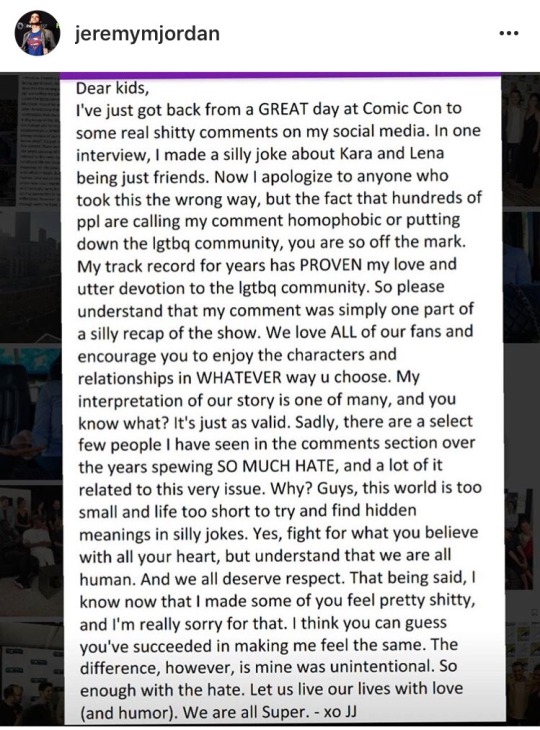
This one, I believe, received the most backlash for a formatting that is closer to that of a non-apology, of which I can see to an extent. It may be messy and imperfect, but he is human and can only learn from his mistakes. Many people did not like the fact that he said, “My track record for years has proven my love and utter devotion to the LGBTQ community.” because some people believe it is the equivalent of, “I have gay family/friends, I can’t be homophobic.”
But he is, I think, absolutely genuine with his intention in the apology, and the second part is more sincere, if you will.
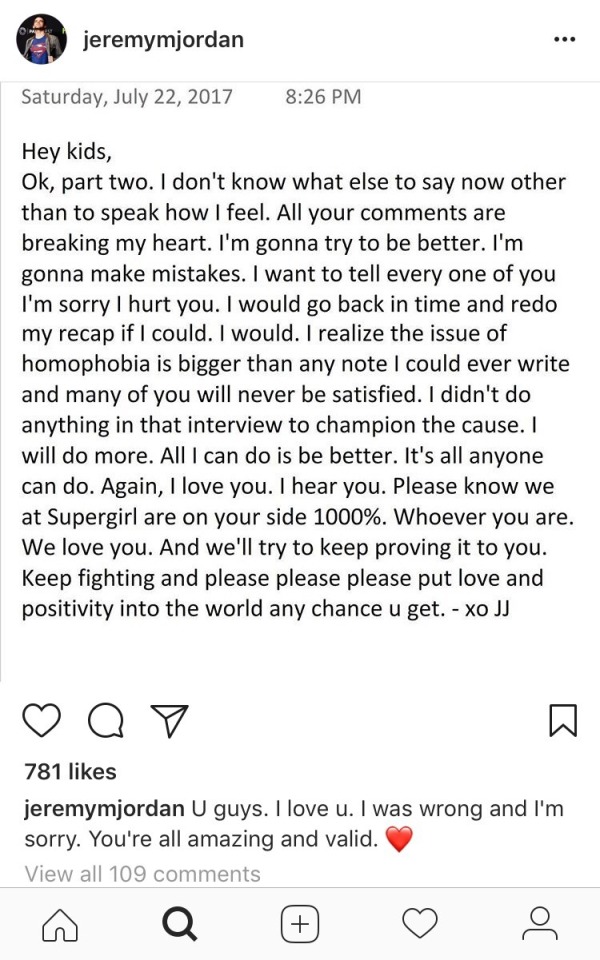
He admitted his mistake, promised he would be better, and I personally have no doubt that he will try to do so in the future.
I said before that when you are attacked or criticized or hated, you are more likely to defend yourself. That is how humans work. If someone you knew was generally a kind and sweet person, but made a huge mistake, you are more likely to blame it on the person’s character. If it was the other way around and you made the mistake, you are more likely to blame it on external circumstances.
Mehcad Brooks’ apology is similar.
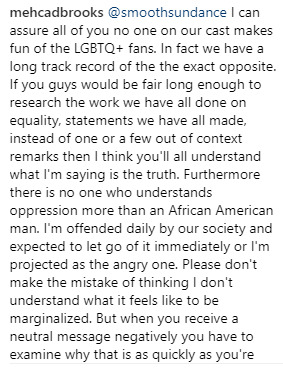

Yes, he made a comment similar to Jeremy Jordan’s “my track record” comment, and said something equivalent to “I cannot be homophobic, I am black”. And maybe he did not mean it to come out that way.
That is also another thing to address, because people who are gay can be racist/sexist and people who are black can be homophobic/sexist and people who are feminists can be homophobic/sexist. Most people know that being oppressed does not mean you cannot be the oppressor.
This is not trying to excuse what they did, but acknowledge that there are absolutely many variables within the situation at hand.
In the musical recap, they were having fun.
Okay, not a great reason, but everyone knows that when you are having fun, in the spur of each moment, you will not know if you are spouting anything out that is rude and offensive. They were not targeting the LGBT+ community, but maybe the actions they partook in are considered homophobic, but they are likely not themselves. They were being silly, having fun with each other, and laughing is scientifically proven to be contagious - it is a social thing whether or not you enjoy it, because most humans thrive off of it, and therefore, desire to be accepted. But, again, I know it does not excuse what they did.
Their intent was not to invalidate the LGBT+ community, but it did regardless, and you have every right to be upset. But think, just for a few seconds, to consider all sides. If you create something as an artist that you are so proud of and put so much time in and it is overlooked towards something you unintentionally created, you will likely feel upset. That one thing that you did not mean to do and put as much work in is being praised rather than the actual thing you are so proud of and want compliments for. Imagine that it is what the majority only talk about, it can get annoying.
Then there was the unnecessary interjection Chris Wood made about sexuality only being about perception of others. Again, ignorant and insensitive, but to his defense, he did say he was being sarcastic right after. I personally believe that was a homophobic comment. It is unfortunate for him that he is receiving a ton of hate attacking his personal life (because his character, Mon-El, is nothing like the comic counterpart and portrays someone who seems abusive), and when you shout at someone, you are likely to be shouted back at with the same force. Again, not excusing him, but more trying to develop an understanding of all sides.
To reiterate, I create art, whether it is in written or visual form, and I will likely be proud of my feat. There will be blatant haters, but when a fan articulately and professionally comments on how my work is portraying something unhealthy, it is a red flag. It is my job to at least take a second for myself to contemplate their words and the possibility without bias and acknowledge that though I did not intend to make it that way, it still had that affect.
They were also tired.
Okay, perhaps also not the greatest excuse for most.
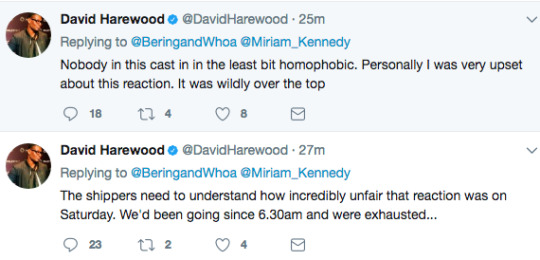
SDCC panels are stressful for everyone, and I also believe it is very much so for celebrities attending. David Harewood makes a point that people may be “unfair” and “over the top” and blasting the situation out of proportion. My only qualm with his tweet is that he refers this outburst only originating from shippers when it is the entire LGBT+ community that has been affected. They might not be homophobic, but their actions could be read that way and will be used in the future to hurt the LGBT+ community and they are responsible for that.
They are also celebrities, they are constrained and choked in a suffocating environment that many fans burden their shoulders with.
Expectations. Ideals. Presumptions. Many unrealistic.
They are stuck within a tiny box of those specifications and the moment they resist or reach past it in any way, they receive hate. They are people, and like many other people, they may be agreeable on some matters and disagreeable on others; they have their own views. Those perfect ideas of humans people have, not just idols nor icons, are bad and unfair for both sides.
There are so many things that infuriated people at Supergirl’s SDCC.
From the announcement of The Ray and how it made Jewish coded characters like Supergirl and the Flash actual Nazis.
Which I personally loathe, so I cannot be as impartial on that matter.
To Melissa Benoist’s statements that Kara Danvers “lost her first ever boyfriend” as well as comparing it to her “losing her entire world”. She completely omitted a great black man in the first season that the latter was so head over heels with and seems to have compared a loss of a boyfriend to her losing her entire world - by extension forgetting that Kara Danvers still has Eliza, Lena, James, J’onn, Winn, and her sister Alex (I believe the Danvers sisters’ relationship is the most powerful in the show).
To the questions and panels circling around Mon-El constantly with barely any input on the Danvers sisters and the involvements of other important lead characters.
To the lack of addressing the problem with Mon-El’s character, which has been a huge controversy in numerous articles as well as plot holes with the rushed and messier writing.
To the theorizing and speculation people are making by watching videos, like the musical recap.
They are videos, you cannot really determine emotion nor intent and all they will ever be is speculation, because people are sharing statements that there is now cast drama (which I hope not) due to this incident. Katie McGrath and Odette Annable are receiving the least hate out of everyone (I am referring to cast members who were present, so I am leaving Chyler Leigh and Floriana Lima out) because (and some of these are fan speculations and may or may not be ridiculous to you)...
- Katie McGrath repeated that fans could take anything they wanted from the show and apparently Mehcad Brooks told her to “shut up” in Italian (zitta).
Honestly, the audio is not great and neither are human ears and it is just speculation. I do not know.
- Katie McGrath “dragged” the rest of the cast members by stating, “I brought it back to reality, you wanna go back to singing again?” as in referring to the musical recap in the video as well as leaning away and apparently tackling Chris Wood’s comment earlier about sexuality only being about perception and Odette Annable showing her support.
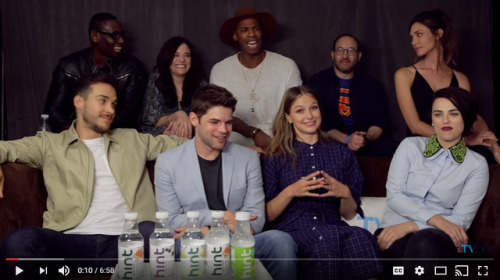
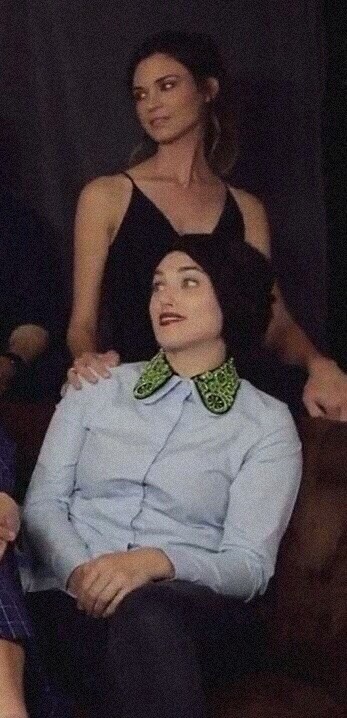
Again, speculation as I analyze with a neutral lens. Katie McGrath could be comfortable in that position. Or maybe she was actually uncomfortable with the situation. And the cast was singing shortly beforehand, it was probably not meant as shade. I do not know.
- Odette Annable did not laugh at the musical recap nor when the cast sang again about Daxam I think.
Maybe she does not find singing to be amusing? Or maybe she really thought the cast members were being rude about the musical recap. I do not know.
- There is a photo of Katie McGrath and it looks as if there are tears and people speculate it was due to her statement during the musical recap that allegedly went ignored by other cast members or something and now she is being ostracized.

More speculation, maybe she was so happy with fans she teared up, maybe the lights were too bright and her eyes were too dry. I do not know.
I do not know. No one knows for sure what is going on and hopefully everyone’s speculations above are wrong because the idea of supposed discourse and schisms within a cast of grown adults is honestly sad (someone said that cast members for a show were arguing before an interview, I do not know how reliable that information is).
If you have a problem with what happened, give your statements.
Don’t attack the actors’ and/or writers’ personal lives.
Most people will not pay attention to something that sounds aggressive or hateful. Educate them on the consequences of their actions in a professional manner, and if they shoot back with something immature or block you, then you are wasting your time and theirs. You are the consumer, you can move on and invest your emotions, money, and time on something that you consider is more worth your while.
#supergirl#sdcc#sdcc2017#sdcc17#lgbt#lgbtq#lgbt+#katie mcgrath#odette annable#melissa benoist#jeremy jordan#mehcad brooks#david harewood#chris wood
306 notes
·
View notes
Note
I feel like if cis queers can't use cis/het then neither can straight trans people. Because the term is meant only for both trans and gay/bi/etc. Ppl. I've used the term but I don't use it to absolve myself of any transphobia, I just use it to describe straight, cisgender people. Should I just be using "non LGBT"? Or something?
Go reread what I wrote. I’ll even copy-paste it here for you.
---
Cisgender LGB people: I see a lot of you speaking about ‘the cishets’ with some kind of bitter taste behind it but never acknowledging your own cisgender privilege and how much transphobia there is in the LGBT community and I want you to know that you’re not fooling anyone.
---
the reasons:
- to distance themselves from their transphobia and transmisogyny.
- to replace the way they have talked about ‘the straights’ as a coherent group when they didn’t want to consider that other people might face any kind of oppression
Pretending that ‘lgbt’ and ‘cishet; are coherent blocks that have all experiences in common is a convenient way to ignore their own transphobia, transmisogyny and cisgender privilege all while providing a tool to exclude people.
Vocal acephobes do this the most, accusing asexual and aromantic people of being ‘cishet’, resisting any kind of solidarity with other issue groups because it would bring the lgbt community in contact with ‘the cishets’.
It’s gross and it is so obviously holding lgbt/queer movements back, keeping them trapped in debates about who is ‘cishet’ when they so desperately need to be building a strong wide resistance to the rise of neofascism.
if you create a strong enough ‘us vs. the evil irredeemable cishets’ mentality this can be used to avoid all accountability ever.
Don’t like being confronted with your racism? Target all your racism at a cishet POC who did something homophobic once. If a POC from the lgbt community calls you out on it you can call them ‘divisive’, you can accuse them of collaborating with the evil ‘cishets’, you can ask them why they hate gay people, etc. etc.
If enough white lgbt people with a similar mindset support you, you can create a culture where racism is okay as long as the target it not lgbt, and this will drive away persky lgbt POC who might talk about white privilege and other uncomfortable topics or who might at some point catch you just being plain old racist to everyone.
Don’t wanna be confronted with your ableism? ditto.
---
It’s not like there this is no circumstance in which cisgender lgb people can use ‘cishet’, although really, ‘cisgender and straight’ would be more accurate because it is important to recognize that they are two seperate parts of an identity and two seperate forms of privilege.
It’s just that I do NOT want people using ‘cishet’’ for everything they hate while ignoring their own cisgender privilege and the amount of transphobia that exists in LGBT+ spaces. If you acknowledge that cisgender privilege is a thing, acknowledge it all the time, including when you look in the mirror.
There is also a side issue of people using ‘cishet’ to exclude asexual and aromantic people from LGBT+ spaces. Those people are horrible aphobic shitheads.
AND there’s a side issue (often overlapping with the aphobia issue) of liberal LGBT people presenting ‘cishets’ as a coherent enemy who is irredeemably evil, as a way to keeps us boxed in, focussing only on our own group instead of creating bonds with people we have a lot in common with.
So if our group is trans people, liberal identity politics has us rooting for rich powerful trans people but not for the cisgender disabled man next door, even though that guy has experiences of oppression that are a lot closer to ours than a trans celebrity ever will.
If we’re going to create real revolutionary change we need cross-identity solidarity. Presenting all ‘cishets’ as inherently evil both erases transphobia within our own ranks and keeps us away from groups who we could work with to make this world better.
37 notes
·
View notes
Text
2013 Interview for Lee Witney (never published)
1. Why have you chosen to create with this medium, what are you trying to communicate and why is it important to you?
The answer is a complex one, because what we end up doing in our lives is often a result of many different experiences. The obvious, uninteresting answer is that we've always been fascinated by games and video games, as most kids are. As friends (we met when we were 17 and 20, respectively) we were enjoying discussing our different play experiences, analyzing them, and imagining how we'd have done things differently. It started as a fun exercise of thinking "what if” we had a voice in the making of our favorite games, and as naïve sense of discovery about how things work. When we grew up and began to feel like we had something to say for ourselves, games were naturally the medium we had invested lots of thought in, and we had matured a genuine belief in its expressive potential. We decided to actually start making games with the intention to create something that wasn't catering exclusively to the games world, but was also aimed at a non-gaming audience, who share our sensibilities for themes and aesthetics. We are interested in seeing how things that are typically communicated with other media look through the medium of games and video games (like politics, for example, in our 2013 game http://finalcandidation.it that we designed for the Italian elections).
2. The term 'Game' seems quite limiting for a tool that allows a person to interact with another's ideas. Do we need a word that articulates the medium accurately, that embraces protean experiences, if so could you suggest one?
It could be argued that words like "game" and "play" are not limiting in themselves. They accommodate many different meanings that keep changing based on locations, players, social interactions, narrative content, and more. Games may be perceived as puerile, because they represent concepts and actions that are deeply rooted in our human nature, but are typically experienced for the first time during infancy. We've found that trying to define the meaning of the term "game" or "play" could be as hard as defining the meaning of the term "art". We like to consider play as a behavior and to think of games as tools that enable a play behavior. This way we do not have to think in terms of restrictions such as goals and rules. Instead, we focus on what, to us, are more important design challenges like “inspiring actions”.
3. It is important to respect history but not be constrained by it. In the mediums inauguration developers innovated because they basically had a blank canvas. Where are we now, are we bound by our history or enriched because of it?
As you say, in art, history certainly has this dual effect -- it simultaneously restrains and frees the artist. This might be true for every medium, and it might simply depend on the approach. Surely, games themselves suffer from an excessive dependence on the history of video games. We wonder if it is because game-making was for so long only relegated to engineers. On the other hand, even people with different backgrounds today choose to make “retro games”. For instance, pixel-art is extensively celebrated, often merely out of custom or tradition, without considering the implications. There is nothing inherently wrong with making games about old games, but it is a little saddening when this celebration is all that creators are interested in participating in. Imagine if every movie was like Michel Hazanavicius’s “The Artist”.
4. How can you sell diversity to risk averse consumers, especially when the work of the imitator is embraced more than the risk taker?
There was a very interesting talk by Nathan Vella at GDC China in 2012, called “Perhaps a Time of Miracles Was at Hand: The Business & Development of #Sworcery” that explains how Capybara Games managed to have a successful product by relying on a completely niche market. If the question is about surviving while making the games we want, then Nathan’s talk possibly has the answer: there is always a niche market large enough that shares our mindset, and fortunately, contemporary distribution models enable us to reach them. We, personally, do not worry too much about the “risk averse” consumers. They will eventually turn to things they are more interested in as they develop their passions and taste. What is more important is to reach people that are interested in diverse entertainment or culture that resonates with them. The interesting part is that these people may not be familiar with games, or may have never considered that games can satisfy their need for low-fi, political science fiction worlds, and the challenge is to reach those people.
5. What responsibilities do consumers have? Their demands for the videogame to be respected contradict their buying habits; which support the same immature themes over and over again.
It is tempting to say that consumers have a responsibility. When people keep buying the third or fourth chapter of the same game with more than two hundred updated guns for $69.99, well, it’s very tempting to point fingers. But developers have really as much of a responsibility -- to do whatever they can to make the games they want to make, without starving. Let’s face it: nobody is in the game industry because “it’s an easy job”. It isn’t. Crunches, sacrifices are way too common, and it is mind boggling how so many devs are willing to go through that to work on games they dislike. Some of them might be trapped in some financial loop where they are stuck in producing the most profitable game possible, but that can’t be the final goal for people that want to express themselves through games. Another responsibility game creators have is to enrich one’s own life with enough diverse experiences. It’s hard to be original in making games if we do not have personal, deep, original experiences to draw from. Finally, it’s really disheartening the amount of sexist, misogynist, overly violent, homophobic, and transphobic content there is in games and it is our responsibility to do better. We face the problem of an audience approaching gaming as pure entertainment and not as a medium capable of convey meaning, and we, as developers, should focus on ways to change that.
6. As new concepts are explored surely critique needs to evolve, especially when trying to define experiences that do not fit into our current forms of measurement. Is there an alternative to how games are currently evaluated?
The technical focus, for instance, could shift to accessibility. Instead of telling us if this or that game is making the best use of a technological expedient, critics could tell us whether it was built with a degree of accessibility appropriate to the audience the game is addressing. It could also be interesting to see mention of relevant media to contextualize the overall experience offered by a game. If you are playing a game about fairy tales, how does your experience relate to different works by Hans Christian Andersen or the Grimm Brothers? Why are these themes treated aesthetically differently in the game with respect to early 20th century illustrations? The tendency to evaluate games only from the game prospective and not refer to the rest of human culture and history can be limiting.
7. What happens to an idea that could advance the medium but fails to tick the boxes under our current review system. Is it left in obscurity or maybe refined by someone else. If so what is the originators role; a sacrificial stepping stone for others?
I like the idea of failures as sacrificial stepping stones. We've been inspired by our own past failures as well as by various unsuccessful game productions from obscure developers in the '90s. There’s nothing wrong with failed projects and going back to see what was good in them. It would be unfair to say that projects fail just because they don’t tick all the review or feature boxes -- there are so many factors to a game’s success.
8. Please explain your definition of quality? Does it reside in a score, an accolade, sales, mass consent, personal opinion or is there something else?
This is a tricky question. It is helpful to distinguish between what we consider a successful execution of the design we set out to realize vs how well-received the final product is. In the first case it is really a matter of scale. Not all projects are born equal, and we always put this into perspective when evaluating the quality of what we create. What was the budget? How much time did we have? The quality is the ability to forecast the scope of the project based on these values and do the best you can under the circumstances. If we couldn’t have made anything better (or, should we say, more interesting), within those constraints, then the project is successful. If, instead, we are discussing success in terms of “enabling us to work on more projects through sales”, for us success can be measured based on whether or not the revenue will allow us to work on a bigger project than the one we just finished. This is especially true now, because we are very small, and we feel we still do not have the funds to work on projects with a big enough scope to let us experiment in the ways we would like. For example, we would love to hire artists and engineers to work with us and add their vision to our projects.
9. The crash of the videogame in the 80s was due to excessive poor quality and saturated plagiarism. Do you think the market could fall again and would that necessarily be a bad thing, especially given that the videogame could be reinvented without the limitations they face today.
Back when video games rose from their ashes, the industry welcomed a new approach to game development, championed by Nintendo, that set the standard for the modern industry until this generation of games. Around this time, the whole developer kit and seal of approval model was invented, in part, to prevent plagiarism. It created a safe environment where customers could finally have fewer but better games, but it also made designing games prohibitively expensive from the start (the sky-rocketing royalties to print cartridges and the cuts Nintendo would take from the sales). The result was fewer, better games on the market but also a culturally sealed world, with not much variety of exp. Today, easily accessible platforms and big online markets like Steam or App Store, things are similar to the 80s somehow, but the medium and the consumers are open to developers with different backgrounds. Meanwhile, thanks to new accessible frameworks like Unity, Game Maker, etc, the barrier to entry is much lower. New generation consoles so far also seem to go further in this direction. The difference might be that we now have the capacity to create independent networks that filter or curate content for end users in efficient and particular ways, so that the public won’t be as lost as it was in the early 80s.
10. How do we pursuit other forms of emotional content if there is always this expectation of fun? What is the most significant hurdle in creating work that might not be accepted commercially or critically?
The separation between “fun” and “emotional” content is not always so clear cut. Many recent games find spaces between these two areas, where interesting, elevated, or even touching content can be experienced through an entertaining series of interactions. Of course there are productions that try to distance themselves from “fun” as much as possible. But there are also many productions that stay somewhere in between these two extremes and could serve as a bridge for players from one type of content to the other. It is also fundamental to understand that fun in itself is not intrinsically related to “laughs” or “delight”. Greek theater was undeniably a form of entertainment, hence “fun”, but its themes go certainly beyond those of comedy.
11. What needs to change in the developer/publisher/consumer/critic relationship to encompass new ideas. Does any one group hold more influence than the others?
Yes, consumers have the biggest influence, as well they should. They are spending their hard-earned money, as they say, and they certainly have the right to get what they want. It is our job to reach out to consumers, critics, and publishers that have a sensibility akin to ours. If publishers and critics are responsible for slowing down the maturing of the medium, it is because they are sometimes slower at capturing the new trends, the new needs of the consumers. Some game experts can fail at seeing how a certain phenomenon, apparently non-game related, is eventually going to radically shape the way games are made. It took a while for everyone to understand, for instance, the potential of tablet/portable/mobile games as a legitimate, expressive platform for games -- the first to understand this were certainly the consumers.
12. In your ideal future what would a videogame represent and how would it be perceived?
As a medium capable of conveying meaning, not just tied to the entertainment industry, we wish for games to be part of an interactive literature, to put in Espen Aarseth’s terms. We hope people will mainly approach video games for what they communicate, rather than for just killing some time. Cinema has a great diversity, from Sundance to Cannes to the Oscars, for example, these are events that celebrate different ways to use the medium, differentiating content and other aspects, all the way down to the duration of the movie itself. We should hope for this kind of diversity for video games in the future. We would also like to see the indie community outgrow what sometimes looks like an elitist behaviour. Self-referencing groups are not bad, per se, and they are pretty common in fields where the research goes beyond the common knowledge on a topic (for example, scientific publications are often aimed at an élite for a reason). But we think it’s not good when our community scorns those who believe that games can also evolve in different directions outside the “indie manifesto”. It feels like we are going against our own goal, which is to explore the communicative power of games. The recent interview with Kurt Bieg (developer of Circadia, Twirdie and SwordFight) at penny-arcade.com addresses this problem in a very critical, but interesting way. It is definitely an important issue, and we cannot afford to lose the voice of talented and passionate developers like Kurt.
2 notes
·
View notes
Text
Force is no substitute for social justice, so let’s dismantle the police
Police in riot gear stand in a line in opposition to protesters subsequent to a message spay painted on the Kenosha County Courthouse in August 2020 after the police taking pictures of unarmed Black man Jacob Blake. (AP Picture/David Goldman)
How ought to a society permit for the reliable use of drive by police? Egon Bittner, the esteemed sociologist who specialised in policing, wrote in his e book Points of Police Work:
“So long as there shall be fools who can insist that their consolation and pleasure take priority over the wants of firemen for area in preventing a fireplace, and who is not going to transfer to make room, so lengthy will there be a necessity for policemen.”
Bittner argued that police “have been created as a mechanism for dealing with the so-called harmful courses.” However the “harmful courses” are merely individuals disadvantaged of the privileges and societal advantages loved principally by wealthy white males.
Let’s think about 5 eventualities wherein drive just isn’t required and the place, due to this fact, police will not be required.
Conditions wherein drive is pointless
Initially, it have to be acknowledged that almost all of on a regular basis life wants no police intervention in any respect — together with protests and demonstrations. That’s as a result of individuals overwhelmingly police themselves, as people, households, street customers, workplaces, associations, communities and protesters.
On the subject of individuals experiencing mental-health crises, what’s required is speak, expertise and persistence. If, in excessive instances, drive is required to restrain an individual for their very own or others’ good, disaster clinic mental-health staff, expert in its minimal use, must be referred to as upon.
The usage of uniformed, armed officers whose modus operandi is to demand obedience to barked orders or to resort to violence is clearly a criminally abusive methodology of coping with such conditions.
The mom and siblings of D’Andre Campbell, who was fatally shot by police in his residence in Brampton, Ont., whereas in a psychological well being disaster, are seen on this July 2020 photograph. THE CANADIAN PRESS/Carlos Osorio
On the subject of visitors enforcement and accident decision, police shouldn’t be concerned. Rushing and different driving violations can now be monitored by know-how or through public complaints. Depart accident decision to insurance coverage brokers or different specialised officers. The place legal driving is concerned, unarmed driving violation investigators can be utilized.
The fast decriminalization of the possession of narcotics and different medicine (past marijuana), as Canadian chiefs of police are recommending, is important. Habit have to be considered a public well being problem to be handled by the suitable specialists. Decriminalizing your entire illicit drug business and regulating it like another enterprise would, clearly, take away the necessity for drive by police in what’s in any other case an enormous space of legal legislation enforcement.
As a substitute, we must always create new organizations to deal with a lot of what police do right this moment.
Pressure doesn’t forestall or resolve crimes
The usage of drive by police neither prevents nor solves crime for the overwhelming majority of legal offences. The truth is, as Bittner wrote in his e book:
“When one appears to be like at what policemen really do, one finds that legal legislation enforcement is one thing that almost all of them do with the frequency positioned someplace between nearly by no means and really not often.”
Detective work actually doesn’t require the usage of drive. It could actually proceed to be carried out by unarmed, plainclothes specialists educated in speaking to witnesses, conducting interrogations, assessing crime scenes and accumulating proof.
We’re due to this fact left with an issue. In Canada, spending on police in Ontario, British Columbia and Alberta is rising at a quicker charge than different municipal spending because the nationwide crime charge decreases. And within the largest 150 U.S. cities, police budgets have risen steadily for many years, whilst crime decreased and through financial downturns, in response to knowledge compiled by the Lincoln Institute of Land Coverage from U.S. census data.
This means, accurately, that policing has little or nothing to do with legal legislation enforcement. As crime has gone down, police budgets have gone up. So what’s policing for?
As Bittner argued, it’s about defending the rich from the “harmful courses.”
Threats to order, property
The “harmful courses” are those that are seen as a risk to public order and property rights. The job of police has lengthy been to impact management — colonial, racial, class, gender and/or sexual — over residents. Clearly, it’s time for this to cease.
The answer lies not with implementing financial and social inequality, however in eradicating it. Placing our tax cash in direction of this — for instance, by constructing inexpensive housing — makes much more sense than shoring up a police establishment that’s too usually brutal, colonial, racist, sexist and homophobic.
Police use chemical irritants and crowd management munitions to disperse protesters throughout an indication in Portland, Ore., on Sept. 5, 2020. A whole bunch collect repeatedly for rallies and marches in opposition to police violence and racial injustice following the demise of a Black man, George Floyd, in police custody in Minneapolis in Could. (AP Picture/Noah Berger)
Whereas there’ll all the time be events when reliable drive by police is important, they’re comparatively few — and police shouldn’t be militarized in weaponry, rank or uniform. Eliminate all three, aside from some small arms held in reserve to be used solely in exceptionally harmful conditions. Different companies or officers can do a lot of what police do now.
So let’s defund the police and put the financial savings into social companies. However let’s go additional, and disband police forces as they’re at the moment configured and substitute them with area people organizations, some extremely educated members of that are empowered to make use of drive as required by fellow residents and in response to circumstance.
Peter Anthony Eglin doesn’t work for, seek the advice of, personal shares in or obtain funding from any firm or group that will profit from this text, and has disclosed no related affiliations past their educational appointment.
from Growth News https://growthnews.in/force-is-no-substitute-for-social-justice-so-lets-dismantle-the-police/ via https://growthnews.in
0 notes
Photo
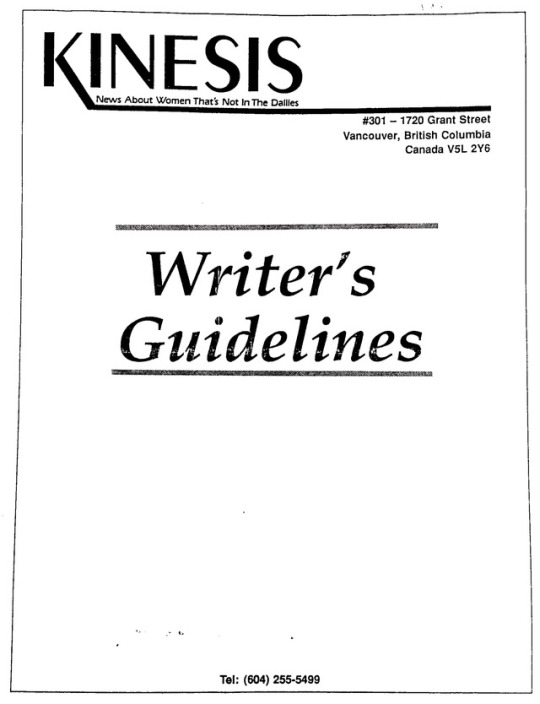
Kinesis: News About Women That’s Not In The Dailies, on language sensitivity and unbiased writing
The magazine Kinesis was published from 1974 to 2001 by the Vancouver Status of Women. It was founded during a particularly vibrant period of women’s self-publishing; periodicals and journals such as Makara, Off Our Backs, The Pedestal, The (Other) Woman, Pork Roast, The Rag and countless others became mainstays in Vancouver feminist communities, offering alternative sources for news that actively worked to disrupt media systems of oppression.
Beyond reporting on “news about women that’s not in the dailies,” they also provided female reporters with a platform to publish, and encouraged women without professional backgrounds to develop their journalism skills. In a 1985 handout titled “Kinesis Writers Guidelines” (which can now be found in the the Vancouver City Archives pamphlet collection), Kinesis outlined the process of submitting an article to be included for publication [1]. A particularly important section of that document is titled “Language and Bias Sensitivity Guide.”
Kinesis established an editorial framework which understood that writers have a responsibility to their representations of people. The english language, after all, can be considered a colonialist device, and -- like mostly anything in a patriarchal culture -- it is also overwrought with many naturalized biases [2].
The sensitivity guide details several subsections, including “Race and Culture,” “Class,” “Sexual Orientation,” “Disability,” and “Age and Appearance”. If Kinesis were still being published today, the list would likely have been updated to include more information on Indigenous Politics and Gender Identities, but the concepts present in the 1985 version are still hugely important introductions to the responsibilities of representation.
While hard copies of Kinesis can be found at both the SFU and UBC RBSC archives, the UBC Digitization Centre has made the UBC RBSC holdings available for online viewing [3]. The aforementioned “Language and Bias Sensitivity Guide” can be found transcribed in its entirety below.
LANGUAGE AND BIAS SENSITIVITY GUIDE
Introduction
Words are powerful. They can challenge stereotypes, overturn common assumptions and initiate the process of social change. They can also perpetuate sexist, racist, classist, ableist and homophobic attitudes.
Part of our work at Kinesis involves developing greater awareness of how our perspectives as writers -- even the words we choose -- are influenced by our cultural and class backgrounds. As feminist journalists, women at Kinesis have long been part of the collective process of rooting out, then changing, the sexism embedded in ordinary English usage. We no longer buy the idea that “mankind” is an inclusive term or that “girl” is a harmless way of describing a 40-year old women. [sic] In the same way, we are also in a process of discovering how language can reduce or make invisible the lives of people who don’t fit the stereotype of what is “good and normal.”
We present this guide as a work-in-progress: a brief description of some of the most common ways bias creeps into writing, along with some suggestions for change. Every woman who sits down to write is taking up a difficult, even scary, challenge. Many of us are unsure about our “voice” or are inclined to quickly self-censor. Our hope is that this guide will encourage women by triggering a new awareness about old ways of writing.
The blank page at the end of this section is for you to record any observations, questions or ideas you may have about bias in writing. Kinesis welcomes feedback and hopes that women will talk together about writing problems and solutions. Future versions of this work-in-progress will depend on your feedback.
Note: Kinesis has material on writing without bias which writers are welcome to borrow.
Race and Culture
Many words and phrases in English carry the weight of a history of racism. The words “white or light,” for example, are usually associated with goodness and purity, while “black or dark” are associated with negativity and evil. Similarly, a white lie is insignificant but a black lie is very serious. Writers can avoid reinforcing this kind of racism by choosing alternatives for words with negative, racially-related connotations. For example:
blacken…….....defame
black eye……..mark of shame
black hearted...malevolent
blackmail…......force, coerce
blacklist…..…...list of undesirables
black humour....bleak humour
Writers should take care not to assume that every issue or event affects every woman in the same way. Generalizations about women’s experience can obscure the different circumstances, priorities and analyses of specific groups of women. It would be inaccurate, for example, to write a story about reproductive rights as if choice on abortion were the most important issue. Although the white women’s movement may have focussed on abortion, for women of colour the abortion issue has been one part of a larger struggle which includes an end to sterilization abuse, population controls, birth experimentation etc.
Some of the terms used to describe colour, race and culture are so broad they convey very little. “Oriental,” for example, is a vague word that can refer to many different peoples. Writers can avoid over-generalizing by choosing more specific terms based on the country an individual comes from. The most appropriate terms are those that arise from each country or culture’s definition of itself.
Seemingly innocent words and phrases can reinforce ethnocentric viewpoints by making dominant white values and perceptions a standard. The word “minority,” for example, is frequently used to refer to people of colour, although, globally, people of colour are the majority and white people are the minority. Similarly, the phrase “visible minority” begs the question -- visible to whom? Writers can avoid the tendency to imply that white is the norm by choosing more accurate and informative phrases. Rather than “non-white,” for example, writers can use more specific terms such as Black, Native or South Asian.
Many of the terms used to distinguish between highly industrialized and less industrialized parts of the world carry subtle messages about the superiority of the industrialized world and, by implication, the superiority of white culture. These phrases include: “developing nations, underdeveloped nations, First, Second and Third world.” Consensus has not been reached about alternative terms, so writers should respect the words women choose to describe themselves.
People of colour are often presented as a burden to the rest of the world. Adjectives such as “poor, underdeveloped, backward, primitive, uncivilized, culturally deprived, and economically disadvantaged” reinforce that view. Writers can avoid feeding into this by presenting information in a positive way, making clear the initiatives people of colour have taken, the solutions they��ve found. For example, “Black people were given their freedom” suggests that Black people played a passive role in historical change. “Black people won their freedom” emphasizes the active role Black people played in their own liberation.
In general, try to be aware of the powerful and destructive influences imperialism and colonialism have had, and continue to have, on people of colour both in Canada and around the world. Although racism is a serious problem for all people of colour in Canada, writers frequently present racism as if it were something that happens only in other countries. Kinesis writers are encouraged to take the time to learn more about the past history and current struggles of people of colour in Canada.
Class
In Canada and the U.S., poverty is rarely presented in the context of class. In Canada, we hear about disadvantaged regions, or regional disparity more than we hear about the working class. As writers (and readers), most of us have been taught that Canada is a classless society. According to this message, anyone can “make it” and if they haven’t it’s because they haven’t tried hard enough, or they are lazy, or they lack the initiative to move to a better-off province or they are, at best, stupid.
This message says that poor people are responsible for their situation and that society, despite its best intentions, is helpless to aid them because they won’t help themselves. In fact, people who are poor are just as likely to be workers as on welfare. The problem is not that poor people don’t work, it’s that they don’t get paid and adequate wage for the work they do. When writing about poverty, strive to include this “big picture.”
No clear line can be drawn between class and race issues. For example, people of colour’s opportunities for education and economic security are often limited by subtle and overt forms of racism in Canada and elsewhere.
When writing on poverty issues, it is important to consider how women of colour will likely be affected -- usually more severely -- by whatever economic factor being examined. The Free Trade agreement, for example, will adversely affect women’s job security and employment prospects. For women of colour, the impact will be especially harsh since the most vulnerable sectors -- agriculture, the garment trade, the fish canning and packing industries -- employ a high percentage of women of colour.
Certain phrases play into misconceptions about the lives of poor women. For instance, “all women are poor” or “every woman is just a husband away from welfare” simply aren’t true. Women from middle and upper class backgrounds will almost always have more economic possibilities than working class women. Some phrases are patronizing, such as “the poor,” “the downtrodden;” instead, try “women who are poor” or “working class women.”
Make efforts to talk to individual women who are living in poverty. People who are poor are often presented as a faceless, nameless mass which makes identification with their struggles almost impossible. As much as possible, seek out and emphasize the political analyses of poor women, and write about the battles these women have fought and continue to fight.
Sexual Orientation
When a writer makes broad generalizations about what women want with respect to relationships, marriage, birth control, families, sexual expression, health issues etc., they are likely denying the particular concerns and experience of lesbians. At the same time, writers may fall into the trap of believing mainstream myths about lesbians: for example, that lesbians aren’t mothers, or that lesbians don’t live in families.
Whenever possible, try to be specific: instead of “Birth control is an important personal issue for women” say “Many heterosexual women see birth control as an important personal issue.”
While there is no clear consensus among lesbians and gays to a preferred descriptive word, the most popular terms are “gay people,” “lesbians,” “dykes,” “gay women and gay men.” “Lesbian woman” is considered by some to be redundant. Avoid terms “homosexual” and “sexual preference” (homosexual exists in relation to a heterosezual standark; heterosexual people aren’t described as having a seuxal preference.) Instead, use “sexual orientation.”
Disability
People with disabilities are assaulted everyday by language which limits their potential for growth and independence -- and dehumanizes them. Many commonly used metaphors are evidence of the negativity and fear with which disabilities are regarded; for example, “blind with rage,” “crippled by poverty,” “deformed by sexism” and “turn a deaf ear.”
When writing about people with disabilities, avoid patronizing cliches such as “afflicted with, deformed by, stricken by or suffering from”; instead, use a neutral term like “affected”. When “disabled” is used as an adjective, there is an implication that the whole person is disabled. Instead of “disabled worker,” for instance, say “a worker with a disability.” Whenever possible, use specific terms (e.g. a person with cerebral palsy) and avoid phrases which diminish a person’s wholeness, such as “the disabled, the handicapped or the epileptic.” The term “normal” demeans people with disabilities; use instead “able-bodied people.”
The following are ways of describing disabilities without implying a person is utterly helpless or without dignity. Rather than “needs crutches,” say “walks with crutches.” Rather than “confined or restricted to a wheelchair” say “uses a wheelchair.” Rather than “dumb” say “deaf or hearing impaired.” Rather than “mentally retarded or mentally incompetent” say “mentally disabled, or intellectually or developmentally impaired.” “Mentally unbalanced, mentally diseased, mental or insane” are appropriate only in a strictly legal sense; instead, say “mental, psychological or emotional disorder.” People who cannot speak are “mute”, not “dumb.” Rather than “stutter, stammer or lisp” say “speech impediment.” “Blind” is appropriate only for people who have no sight whatsoever; for others, use “visually impaired or having low vision.”
Age and Appearance
Women know all too well how much value the dominant culture places on age and appearance: if we’re old or not judged attractive by some males standard, then we’re considered useless.
When describing a person, avoid associating their experiences, ideas or values with their age or appearance. A belief that someone is beautiful and attractive -- or ugly and unpleasant -- is often rooted in a culturally imposed value. Generalizations about people based on their stage of life should also be avoided, such as “wild or irresponsible youth,” and “conservative older generation.” As well, stay away from cliches such as “tender age, declining years, second childhood, behind the times, prime of life, or past her prime.” [4]
Text
Intro: Alexandra Bischoff; “Language and Bias Sensitivity Guide”: Kinesis collective, reprinted courtesy of Nancy Pollak.
Notes/Sources
[1] “Kinesis Writers Guidelines.” City of Vancouver Archives, pamphlet collection fonds; reference code: AM1519-: PAM 1990-83.
[2] Team, The ITunes U. "Postcolonial English." OpenLearn. The Open University, 06 July 2011. Web. 04 Dec. 2016.
[3] Esquin. "Kinesis Is Now Available Online!" Digitization Centre. University of British Columbia, 21 Oct. 2013. Web. 03 Dec. 2016.
[4] “Kinesis Writers Guidelines” located at the City of Vancouver Archives, pamphlet collection fonds; AM1519-: PAM 1990-83.
Image
Courtesy of Nancy Pollak. Kinesis Writer’s Guidelines (Est June, 1985). Located at the City of Vancouver Archives, pamphlet collection fonds; AM1519-: PAM 1990-83.
#kinesis#feminism#feminist collective#feminist writing#vancouver activism#vancouver feminism#vancouver archives#art and archives#women in publishing
0 notes